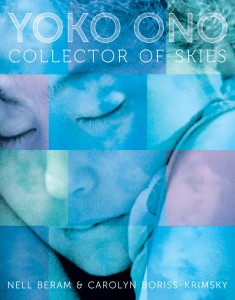JQ Magazine: Book Review – ‘Yoko Ono: Collector of Skies’

“The book’s release is timed to coincide with Ono’s 80th birthday on February 18, and provides readers snippets of info on some tumultuous periods during her lifetime.” (Amulet Books)
By Rashaad Jorden (Yamagata-ken, 2008-2010) for JQ magazine. Rashaad worked at four elementary schools and three junior high schools on JET, and taught a weekly conversion class in Haguro (his village) to adults. He completed the Tokyo Marathon in 2010, and was also a member of a taiko group in Haguro.
“Everybody knows her name, but nobody knows what she does.”
That line—uttered by the most famous of her three husbands—could accurately sum up Yoko Ono for a long time. But that shouldn’t be the case. Fortunately, thanks to a new book co-written by Nell Beram and Carolyn Boriss-Krimsky, readers have insight into this remarkable woman’s life.
Yoko Ono: Collector of Skies—so titled because Ono has always looked to the sky for inspiration—delves into the life of the famous avant-garde artist and musician, from her childhood in Japan and the U.S. to her chart-topping success in her seventies. The book’s release is timed to coincide with Ono’s 80th birthday on February 18, and provides readers snippets of info on some tumultuous periods during her lifetime.
Ono’s journey is presented in an easy-to-read format geared toward young adults. Unlike many other biographies, where all the photographs tend to be lumped together in a couple of sections, the photos in Collector of Skies are spread throughout the book, and they range from one in which Ono is wearing a kimono at the age of two to another taken at the inaugural lighting of the Imagine Peace Tower in Reykjavik in 2007. The authors also use quotes from Ono to expound upon certain periods and moments of her life.
Of course, any story about Yoko Ono has to make heavy mention of her relationship with John Lennon, and the middle of the book is largely devoted to her life with the former Beatle. While Collector of Skies might not reveal anything earth shattering for hardcore Lennon and Beatles fans, younger readers (or those unfamiliar with the Beatles) will learn not just the real story of the group’s breakup, but more importantly, the duo’s activism.
Although the book may be seemingly dominated by her relationship with Lennon, Beram and Boriss-Krimsky devote plenty of time to Ono’s accomplishments in music and art (detailed by a timeline in the appendix) and events that have outlined her individualist streak—such as when, as a toddler, she belted out Japanese children’s songs, behavior that horrified her affluent mother as she viewed those songs as those of commoners.
However, a couple of things are missing from the book—mainly, mentions of how Japan has influenced her work. As Ono seems very westernized (having lived most of her life in the United States), there is really just one mention of Japanese influence on her work: her 1996 work Wish Tree, in which viewers could write their wishes on cards similar to the Japanese customs at temples. A teacher once described Ono as someone who would be “a bridge between the United States and Europe,” so it would have been interesting to learn about other Japanese influences in her work. In addition, Collector of Skies would have been enhanced by a few more quotes from others about her work. There are some, such one from art critic Arthur C. Danto, who described Ono as “one of the most original artists of the last half-century,” but it would have been great to read about how others have viewed her work.
Overall, Collector of Skies does an outstanding job of bringing to life the story of an amazingly talented artist; one who certainly doesn’t seem to be slowing down.
For more JQ magazine book reviews, click here.


Comments are closed.